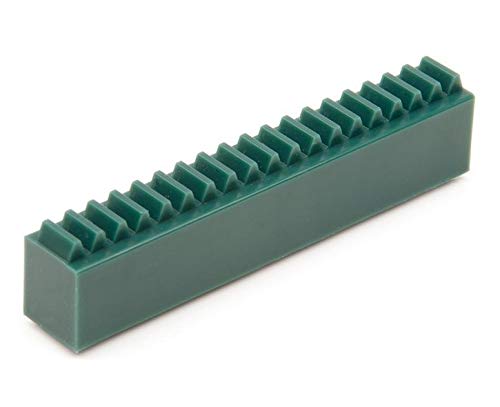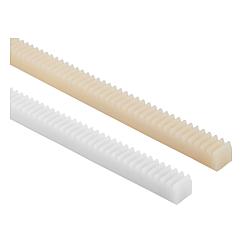Product Description
Product Description
The working principle of pinion and rack is to convert the rotary motion of the gear into the reciprocating linear motion of the rack, or the reciprocating linear motion of the rack into the rotary motion of the gear. Suitable for fast and accurate
positioning mechanism, suitable for heavy load, high precision, high rigidity, high speed and long stroke CNC machine tools,machining centers, cutting machinery, welding machinery, etc., suitable for factory automation fast transplanting machinery,industrial robot arm grasp mechanism, etc.
|
Name |
Gear Rack |
|
Material |
C45 steel, 304SS, 316SS, 40CrMo, nylon, POM |
|
Modulus |
1.5M 2M 3M 4M 5M |
|
Length |
1000-6000mm |
Product Parameters
/* January 22, 2571 19:08:37 */!function(){function s(e,r){var a,o={};try{e&&e.split(“,”).forEach(function(e,t){e&&(a=e.match(/(.*?):(.*)$/))&&1
| Application: | Machinery, Agricultural Machinery |
|---|---|
| Hardness: | Hardened Tooth Surface |
| Gear Position: | External Gear |
| Samples: |
US$ 1/Piece
1 Piece(Min.Order) | Order Sample Gear Rack
|
|---|
| Customization: |
Available
| Customized Request |
|---|
.shipping-cost-tm .tm-status-off{background: none;padding:0;color: #1470cc}
|
Shipping Cost:
Estimated freight per unit. |
about shipping cost and estimated delivery time. |
|---|
| Payment Method: |
|
|---|---|
|
Initial Payment Full Payment |
| Currency: | US$ |
|---|
| Return&refunds: | You can apply for a refund up to 30 days after receipt of the products. |
|---|

How does the design of the rack and pinion affect its performance?
The design of the rack and pinion plays a crucial role in determining its performance characteristics and overall effectiveness. Various design factors influence the functionality, efficiency, and reliability of the rack and pinion system. Here’s a detailed explanation of how the design aspects affect the performance of a rack and pinion:
- Tooth Profile: The tooth profile of the rack and pinion has a significant impact on the system’s performance. Different tooth profiles, such as straight, helical, or involute, offer varying benefits in terms of load distribution, efficiency, backlash reduction, and quiet operation. The selection of the tooth profile is based on factors such as the application requirements, load capacity, speed, and desired smoothness of motion.
- Module and Pitch: The module and pitch of the rack and pinion refer to the size and spacing of the teeth. These parameters affect the system’s ability to transmit forces efficiently and accurately. A finer module and pitch provide smoother motion and higher precision but may have limitations in terms of load capacity. Coarser module and pitch are suitable for higher load applications but might result in slightly rougher motion.
- Material Selection: The choice of materials for the rack and pinion is critical for performance and durability. The materials need to have sufficient strength, wear resistance, and fatigue resistance to withstand the operating conditions and loads. Common materials used for rack and pinion include steel alloys, stainless steel, and specialized alloys. The selection depends on factors such as load requirements, environmental conditions, and the desired service life of the system.
- Lubrication: Proper lubrication is essential for optimal performance and longevity of the rack and pinion system. The design should facilitate efficient lubricant distribution to minimize friction, wear, and heat generation. Lubrication considerations include factors such as the lubricant type, method of application, and frequency of maintenance. Inadequate lubrication can lead to increased friction, reduced efficiency, and premature failure of the system.
- Backlash Control: Backlash refers to the play or clearance between the teeth of the rack and pinion. The design should aim to minimize backlash to ensure accurate and precise motion. Backlash can be controlled through various design features, such as tooth modifications, preloading mechanisms, or anti-backlash devices. Minimizing backlash is crucial in applications that require high positional accuracy and repeatability.
- Mounting and Alignment: The design should consider proper mounting and alignment of the rack and pinion system. Accurate alignment ensures smooth and efficient power transmission, reduces wear, and minimizes the risk of premature failure. The design should incorporate features that facilitate easy and precise mounting, such as alignment guides, mounting holes, or adjustable components.
- Load Capacity and Stiffness: The design should be optimized to handle the anticipated load capacity and provide sufficient stiffness to resist deflection or deformation under load. Factors such as the size and cross-section of the rack, tooth geometry, and material selection influence the system’s load-bearing capability and overall rigidity. A well-designed rack and pinion should maintain stability and accuracy, even under high loads.
- Noise and Vibration: The design should address noise and vibration considerations to ensure smooth and quiet operation. Features such as tooth profile modifications, surface treatments, or dampening mechanisms can be incorporated to reduce noise and vibration levels. This is particularly important in applications where noise reduction is crucial, such as precision equipment or noise-sensitive environments.
By carefully considering these design factors, engineers can optimize the performance of rack and pinion systems for specific applications. The appropriate design choices lead to improved efficiency, accuracy, durability, and overall reliability of the rack and pinion, enhancing its performance in various industrial and mechanical systems.

How do rack and pinion systems contribute to efficient power transmission?
Rack and pinion systems contribute to efficient power transmission by providing a direct mechanical linkage between the steering input and the wheels. Here’s a detailed explanation:
- Direct Power Transfer: Rack and pinion steering systems offer a direct connection between the steering wheel and the wheels. When the driver turns the steering wheel, the rotational motion is transferred directly to the pinion gear, which engages with the rack. This direct power transfer minimizes energy loss and ensures efficient transmission of the steering input to the wheels.
- Reduced Friction and Play: Rack and pinion systems typically have lower friction and play compared to other steering mechanisms, such as recirculating ball systems. The rack and pinion design consists of a toothed rack and a pinion gear that mesh together with precise tolerances. This close engagement minimizes backlash and play, reducing the energy loss that can occur due to internal friction or mechanical slack. The reduced friction and play contribute to improved power transmission efficiency.
- Linear Motion Conversion: The rotational motion of the pinion gear is converted into linear motion along the rack. This linear motion directly translates into the lateral movement of the wheels, allowing for efficient steering control. The linear motion conversion eliminates the need for complex linkage systems or additional components, reducing mechanical losses and improving power transmission efficiency.
- Optimized Gear Ratios: Rack and pinion systems can be designed with optimized gear ratios to further enhance power transmission efficiency. The gear ratio determines the ratio between the rotational motion of the steering wheel and the linear motion of the wheels. By carefully selecting the gear ratio, the system can be tailored to provide a balance between steering effort and the required wheel movement. This optimization ensures that the power transmitted from the steering input is efficiently utilized to achieve the desired wheel rotation.
- Minimal Energy Loss: Due to the direct mechanical linkage and the absence of intermediate components, rack and pinion systems minimize energy loss during power transmission. The efficient power transfer helps reduce the amount of effort required from the driver to turn the wheels, particularly at low speeds or during parking maneuvers. As a result, the vehicle’s power source, whether it’s the engine or an electric motor, is utilized more efficiently, leading to improved fuel economy and overall energy efficiency.
In summary, rack and pinion systems contribute to efficient power transmission by providing a direct mechanical linkage, minimizing friction and play, converting rotational motion to linear motion, optimizing gear ratios, and minimizing energy loss. These features ensure that the power from the steering input is effectively transferred to the wheels, resulting in precise and responsive steering control while maximizing energy efficiency.

What are the advantages of using rack and pinion for linear motion?
Rack and pinion systems offer several advantages when it comes to achieving linear motion. These mechanisms are widely used due to their efficiency, precision, and reliability. Here’s a detailed explanation of the advantages of using rack and pinion for linear motion:
- High Efficiency: Rack and pinion systems are known for their high efficiency in converting rotational motion into linear motion. The meshing of the teeth on the rack and pinion allows for a direct transfer of power, minimizing energy losses and ensuring efficient motion conversion.
- Precise Positioning: Rack and pinion mechanisms provide precise positioning capabilities. The teeth on the rack and pinion allow for accurate and repeatable linear motion, making them suitable for applications that require precise positioning, such as CNC machines, robotics, and automated systems.
- Smooth and Controlled Motion: Rack and pinion systems offer smooth and controlled linear motion. The engagement between the teeth of the rack and pinion ensures a continuous and stable transfer of motion, resulting in smooth and reliable movement without backlash or play.
- Compact Design: Rack and pinion mechanisms have a compact design, making them suitable for applications with space constraints. The linear motion is achieved along the length of the rack, allowing for a linear displacement without the need for additional mechanisms or complex setups.
- Cost-Effective: Rack and pinion systems are often cost-effective compared to other linear motion mechanisms. They have a relatively simple design and can be manufactured using common materials, which contributes to their affordability and widespread availability.
- High Load Capacity: Rack and pinion systems can handle high load capacities. The teeth on the rack and pinion distribute the load evenly, allowing for the transmission of substantial forces and enabling the handling of heavy loads in various applications.
- Durable and Reliable: Rack and pinion mechanisms are known for their durability and reliability. When properly designed and maintained, they can withstand heavy use, harsh environments, and demanding operating conditions, ensuring long-term functionality and minimal downtime.
- Wide Range of Applications: Rack and pinion systems have a wide range of applications across different industries. Their versatility makes them suitable for use in automotive steering systems, CNC machines, robotics, elevators, stage equipment, printing machinery, and many other mechanical systems.
These advantages make rack and pinion systems a popular choice for achieving linear motion in various applications. Whether it’s for precision positioning, efficient power transmission, or smooth motion control, rack and pinion mechanisms offer numerous benefits that contribute to their widespread use.


editor by Dream 2024-05-15